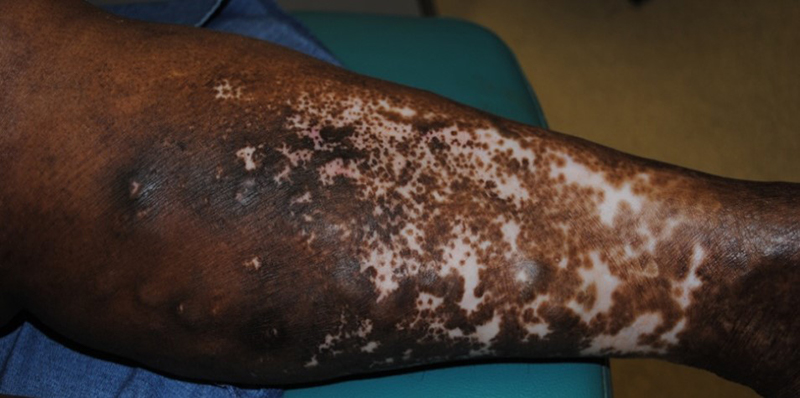
Vitiligo: A Change in Perception
In communities around the world, there is a large significance placed on appearance and aesthetics. Unfortunately, this leads to a negative perception of individuals with visible dermatological conditions. Skin conditions such as vitiligo are viewed as debilitating and are especially noted in deep skin toned individuals, since lesions are more visually prominent. Regrettably, the negative perceptions of these individuals can lead to unforeseen psychological and social implications.
Vitiligo is a skin condition that is comprised of hypopigmented patches in various areas of the body including on the lower extremity. Although the physical lesions are noticeable, the associated psychological and social disadvantages are more than skin deep. Vitiligo is an autoimmune destruction of the melanocytes and is thought to be caused by oxidative stress and genetics.1 Increased catecholamines and neuropeptides have also been indicated in its pathophysiology.2 Ultimately, this manifests as a much lighter pigmentation change compared to the surrounding skin. This process can occur in any person from any ethnic background.
Aside from the clinical presentation of vitiligo, the condition also has a major impact on an individual’s quality of life and sense of self-worth. Individuals with different appearances are usually stigmatized and attract negative attention. This can lead to unnecessary embarrassment, anxiety, and increased levels of stress. For instance, certain religious communities in India have associated vitiligo with individuals who have sinned in previous lives, which only compound the social issues one may already face. Lesions appearing on one’s face, hands or other easily viewed area can lead to difficulty obtaining a job, starting a new relationship or getting married.3 In a study of vitiligo patients in India, a majority were found to have major depressive disorder and social phobia, while 28% suffered from suicidal ideation.4
Since vitiligo is often seen as a contagious condition in many communities, a questionnaire of 1,000 participants that attended primary health care centers revealed that “about 30% believed vitiligo is contagious, 41% believed it is caused by infections, and 22% of the respondents believed that those who have vitiligo are unhygienic”.5 This unwelcoming environment and misinformation certainly increases the psychological effects on the individual.
Although this is a deeply stressful condition mentally, socially, and physically, the population dynamic and level of education of this condition is slowly changing. Pop culture has been in the forefront for promoting awareness about vitiligo and helping those who have it feel empowered and accepted. Winnie Harlow, a fresh face in the modeling industry, has recently found success while showcasing her skin patches instead of camouflaging them. The push towards body positivity and acceptance will hopefully lead to more understanding of the disorder and will help to decrease the mental and social strain on affected individuals.
References
- Nogueira, LSC, Zancanaro PCQ, Azambuja RD. Vitiligo and emotions. An Bras Dermatol. 2009 Jan/Feb;84(1):39-43
- Silverberg J and Silverberg N. Psychological stressors preceding vitiligo onset are associated with itch and intermittent abdominal cramping. J Amer Acad Dermatol. 2013 Apr;68(4):S1:AB189
- Parsad D, Dogra S, Kanwar AJ. Quality of live in patients with vitiligo. Health Qual Life Outcomes. 2003 Oct 23;1:58.
- Grimes P, Miller M. Vitiligo; Patient stories, self-esteem, and the psychological burden of disease. Int J Womens Dermatol. 2018 Mar; 4(1):32-37
- Alghamdi KM, Moussa NA, Mandil A, et al. Public perceptions and attitudes toward vitiligo. Current neurology and neuroscience reports. https://www.ncbi.nlm.nih.gov/pubmed/22971308. 2012 Sep-Oct;16(5):334-40. Accessed January 21, 2019.



Comments
There are 0 comments for this article